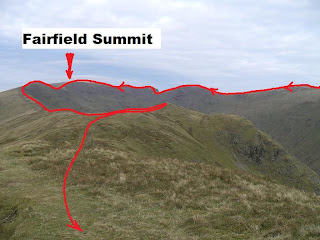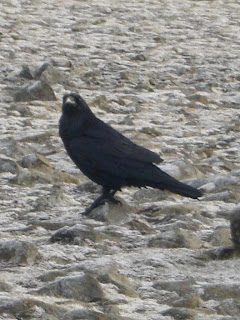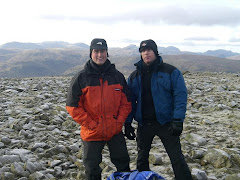With these words of wisdom, Jonathan and I began our training walk that we had decided to do at the end of 2009 to begin our training regime for Kilimanjaro.
Our initial training with the rest of the Sunderland Partnership team had so far been low level walks, so we decided to give ourselves a reminder of what climbing 1000m each day of our 6 day climd might feel like. The cold would become a factor the higher we get up Kili so the ice and sub-zero temperatures on the sold Sunday morning in December were ideal. A great way to test out the layers of walking kit we had both been acquiring over the previous weeks.
The one thing we couldn't work out how to simulate was the effects of altitude that Kili would bring. Fairfield is only 823m high - 5072m smaller than Kilimanjaro. The headaches, dizziness and nausea we have been promised come with altitude sickness - (like a severe hangover they reckon so neither of us can really understand what that might feel like - would be hard to reproduce. Holding our breath as we climbed was the best alternative we could come up with. However, once the frosted had sucked the air from our lungs when we stepped out of the warm car in Ambleside and the initial climb up towards HIgh Sweden Bridge had knocked the cockiness out of us, we decided that holding our breath wasn't the best idea and just completing the walk without freezing should be our main objective.

The walk itself was exhilerating. Some of the steep climbs on the way up had us stopping for breath, but fortunately the icy air and sunshine meant that these stops allowed us to turn to look at the unbelievable views behid us. Those of you who have walked in the Lakes before will know the rare beauty of a clear day and the view from the tops, looking south to Morecambe Bay and west; trying to convince yourself that you can see Ireland.
At times this walk can be boggy in places, but the freezing weather had crisped the ground so it was dry and we made good time. Compared to our route card and the time we expected to take we were walking quickly and set ourselves a very quick pace. We reflected that the climb up Kili was much longer and higher, but would be done at a much slower pace. If you want to get up the big hill, you have t take it slow and steady to give your body the chance to deal with the altitude and the exertion. We will also need to drink 3 litres of water each day during our climb. I had decided to try the weight of this out in my rucksack and was carrying 3 litres to see what the weight was like on top of my other kit. The good news is the weight wasn't an issue. The bad news was that my sandwiches were squashed beyond recognition.

Getting to the top was tremendous as there were snow patches but unusually no wind for a lakeland hill. We used a stone cairn for shelter as we had a squashed sandwich to celebrate our achievement. I regrest to confess dear reader that my chutney was frozen and was reduced to licking it in a vain attempt to thaw it out. Such are the extremes to which we hardy mountain men are reduced and the profound contradictions that make up the enjoyment of conquering a lakelend hill - the views may be breathtaking and inspiratrional, but you still ending up licking your own Branston and there is no way you can make that look cool.
 A local takes an interest in John's sandwich
A local takes an interest in John's sandwichOur descent was quick and the views outstanding, We quickly realised when we reached the steep slopes down into Rydal that for all its slow, trudging, freezing exhertion and altitude sickness, the climb may not be as bad as the descent. The knee-jarring pain on the way down will be just as challenging as we loose the height in only 2 days that it had taken us 6 days to conqueour.
Getting back to the car I am happy to report that our chilly ramble had not put us off the challenge ahead. Rather it had made us both more keen to crack on with the adventure and realise the training we would need to do if were to get to the top of Kili.
In January training awaits.
